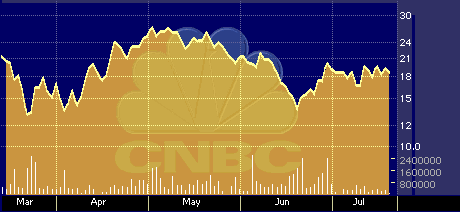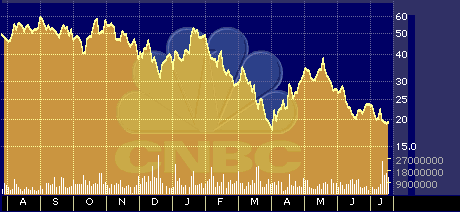
Techs That Thrive in a Slowing Economy
Techs That Thrive in a Slowing Economy
By Hal Plotkin
Silicon Valley Correspondent
Holding high-margin electronic-manufacturing stocks is one of the best ways investors can shelter their portfolios from fears of a slowing economy and potentially higher interest rates, analysts say.
Stocks in the electronics manufacturing products and services (EMPS) sector have handily overcome the uptick in interest rates over the past year to solidly outperform the market during the past 12 months. The Dow Jones Semiconductor Equipment index, which includes EMPS stocks, is up about 107 percent for the past 12 months, compared with 35 percent for the Nasdaq Composite.
Analysts say that a slowdown in the economy would work in favor of market-leading EMPS companies, which already are benefiting from a fundamental shift in the economy, as more firms with familiar brand names jettison their own manufacturing facilities and concentrate on conceptualizing new products, marketing, sales and support.
As that happens, the best contract manufacturers are developing core competencies in design, engineering and manufacturing that make it harder for single-product-line producers to keep up.
Leading contract manufacturers can usually keep their facilities humming all year long, often around the clock, maximizing their efficiency. Product-specific production facilities are often idle because of inventory-management issues, which become particularly problematic during a slowdown.
“[Electronics-manufacturing-services] stocks are not completely immune from a
more general downturn in the economy,” says J. Keith Dunne, an analyst at Robertson Stephens in San Francisco. “But it’s not a cyclical. In fact, if we do get a downturn or even a recession, I would expect the service-oriented EMS companies to do even better as their customers look to cut costs.”
Over the past year or so, larger competitors, often at premium prices, have absorbed more than 10 EMS companies, including Altron Inc., CMC Industries Inc. and Hadco Corp. Dunne says an economic slowdown would only accelerate the trend to outsourced manufacturing and should also lead to lucrative consolidations in the sector.
“We expect composite sales for service-based EMS companies to grow an average of approximately 35 percent over the next year,” Dunne says. “We believe outsourcing activities in the telecommunications sector alone could exceed $50 billion over the next five years.”
“We know the demand for outsourcing is going to continue to be strong,” agrees Tom Cal, an analyst with Wit SoundView in Stamford, Conn. “As the economy becomes more competitive, companies have to move even faster.”
“In 10 years, outsourced manufacturing won’t just be a trend anymore, it will be how things are done,” Dunne says.
Analysts recently singled out two companies, DDi Corp. {DDIC} and Sanmina Corp. {SANM}, which they say are uniquely positioned to capitalize on this opportunity, particularly should other parts of the economy show signs of slowing.
Anaheim, Calif.-based DDi was created through the July 1998 merger, or roll-up, of the company with another leading time-to-market circuit board maker, Dynamic Circuits Inc. The newly combined company went public on April 14, with shares initially priced at 14. The company’s other acquisitions, which include Cuplex, Design Plus and NTI, have also helped consolidate DDi’s position in the quick-turn segment of the market.

DDi Corp. 52-Week Stock-Performance Chart
DDi’s recent initial public offering makes it one of the newer names among publicly traded high-end contract-manufacturing stocks.
Despite recent volatility, analysts say DDi has one of the best business models in its fast-moving sector. The company focuses almost entirely on providing high-margin, quick-turn production of prototype and pre-production circuit boards for the communications, computer and general electronics markets.
“The culture we’ve set up says it is not okay to be three hours late getting product to a customer,” says Bruce McMaster, DDi’s president and chief executive officer. “We have people who think in weeks, not months; days, not weeks; hours, not days.”
More than 50 percent of DDi’s sales are for products delivered within 10 days of when they are ordered, according to the company.
The speed allows DDi to charge premium prices. The average selling price of
circuit-board panels produced in the firm’s Anaheim facility, for example, is $1,127. Once they become commodities, similar boards can be produced for as little as a few dollars each.
Analysts say the ever-increasing pace of the high-tech sector, which forces companies to bring new products to market faster and faster, puts DDi in a position to prosper. That is particularly true, they say, during a downturn, when economic pressures can be particularly punishing to companies that don’t adapt quickly enough.
“They’re getting a huge premium for quick-turning products,” says Needham & Co. analyst John McManus.
Eric Gomberg, an analyst at Thomas Weisel Partners in New York, upgraded the stock to “strong buy” from “buy” earlier this month, after the company announced its pending acquisition of Automata International Inc.
Gomberg, who has a $48 12-month price target on the stock, says the acquisition should boost DDi’s earnings to $1.13 a share in 2001, up from the $1.06 he had previously projected.
He says DDi is delivering a critical and increasingly indispensable advantage to its customers. “In this marketplace, time to market is almost everything,” he says. “You can’t win if you don’t have a product out there.”
Meanwhile, San Jose, Calif.-based Sanmina generates about 70 percent of its revenue from sales of mostly big-ticket items to Alcatel {ALA), Lucent Technologies Inc. {LU}, Motorola Inc. {MOT}, Nortel Networks Corp. {NT} and Solectron Corp. {SLR}.
The average tenure of Sanmina’s customers is 12 years, according to the company.

Sanmina 52-week stock performance chart
“We’ve been able to attract an excellent customer base heavily focused on the communications sector,” says Randy Furr, Sanmina’s president and chief operating officer. “Obviously, we’ve been doing a good job of holding on to our customers.”
Furr delivered a very optimistic assessment of his company’s prospects at a recent investor conference hosted by Robertson Stephens in San Francisco. “I think we’re really poised to see more profitable growth,” Furr said there.
“Sanmina is a special company,” says Michael Morris, an analyst at Salomon Smith Barney in San Francisco. “There’s an almost insatiable demand for the large enterprise-level communications systems, and Sanmina essentially has the whole food chain. Sanmina’s stock is a rifle shot on the high end of the communications group.”
Morris has a “buy” rating on Sanmina’s stock, along with a $122 12-month price target.
McManus has a $135 12-month price target on the stock, which he rates “strong buy.”
“Sanmina is one of the most vertically integrated of all contract manufacturers,” McManus says. “They have a history of 26 consecutive quarters meeting or beating [earnings] expectations. They have the model many other companies are trying to follow.”
Earlier this month, Banc of America Securities analyst Paul Fox reiterated his “strong buy” recommendation on Sanmina’s stock and raised his 12-month price target to 170 from 150.
“We like Sanmina’s position on the high end,” agrees Scott Heritage, an analyst at UBS Warburg in New York. He also has a “strong buy” rating on the stock, along with a $117 12-month price target.


